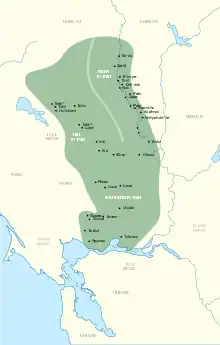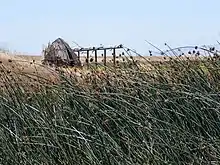Patwin
The Patwin (also Patween and Southern Wintu) are a band of Wintun people in Northern California. The Patwin comprise the southern branch of the Wintun group, native inhabitants of California since approximately 500.[1]

Today, Patwin people are enrolled in three federally recognized tribes:[2]
Territory

The Patwin were bordered by the Yuki in the northwest; the Nomlaki (Wintun) in the north; the Konkow (Maidu) in the northeast; the Nisenan (Maidu) and Plains Miwok in the east; the Bay Miwok to the south; the Coast Miwok in the southwest; and the Wappo, Lake Miwok, and Pomo in the west.
The "Southern Patwins" have historically lived between what is now Suisun, Vacaville, and Putah Creek. By 1800, the Spanish and other European settlers forced them into small tribal units: Ululatos (Vacaville), Labaytos (Putah Creek), Malacas (Lagoon Valley), Tolenas (Upper Suisun Valley), and Suisunes (Suisun Marsh and Plain).
Language
The Patwin language is a Southern Wintuan language. As of 2021, one Patwin person was a documented first-language speaker of Patwin.[3]
Population
Estimates for the pre-contact populations of most native groups in California have varied substantially. Alfred L. Kroeber put the 1770 population of the Wintun, including the Patwin, Nomlaki, and Wintu proper, at 12,000.[4] Sherburne F. Cook (1976a:180-181) estimated the combined population of the Patwin and Nomlaki at 11,300, of which 3,300 represented the southern Patwin. He subsequently raised his figure for the southern Patwin to 5,000.[5]
Kroeber estimated the population of the combined Wintun groups in 1910 as 1,000. By the 1920s, no Patwin remained along Putah Creek and few were left in the area.[6] Today, Wintun descendants of the three groups (i.e. the Patwin, Nomlaki, and Wintu proper) total about 2,500 people.[7]
Villages
.jpg.webp)
Archaeology
Patwin Indian remains were discovered at the Mondavi Center construction site beginning in 1999, and consequently, the University of California, Davis, built a Native American Contemplative Garden within the Arboretum, a project honoring the Patwin.[8][9][10]
Notable Patwin people
- Mabel McKay (1907–1994), basket weaver and healer
- Sem-Yeto (c. 1798 – c. 1851), 19th-century leader and diplomat, also known as "Chief Solano"
See also
Notes
- Golla 2011: 250
- "Native American Contemplative Garden". University of California, Davis. March 16, 2015. Retrieved May 17, 2017.
Today, only three federally recognized Patwin (Wintun) Indian rancherias remain.
- "Patwin – Survey of California and Other Indian Languages". Retrieved 2012-08-30.
- Kroeber 1925:883
- Cook 1976b:8
- Putah Creek: Flowing through Our Communities and Our Lives, Sacramento, California: Putah Creek Council, 2008, p. 21, ISBN 9780615216027,
When Spanish explorers and Russian fur traders came to California, things quickly changed. New diseases such as smallpox and malaria were fatal to many Native Americans, and an epidemic in 1833 emptied the village of Putah-toi. The Spaniards forced many of the remaining Patwin onto the Solano mission. There, disease and deprivation took a heavy toll. When the missions were secularized in the 1830s, the number of remaining Indians was less than one-third that of the Indians who had been pushed there. By the 1920s, no Patwin remained along the creek and few were left in the area. Native American ecological knowledge was lost and continues to be lost, along with the tending that fostered the growth of many California plants. However, efforts are being made to bring Native Americans and their understanding back into the management of California land. Despite obstacles, Patwin descendants still know the plants of this area and still tend them.
- "Wintun Indians". California Indians and Their Reservations: An Online Dictionary. San Diego State University Library. Archived from the original on 26 July 2010. Retrieved 30 June 2010.
The Wintun Indian people have three divisions: the Wintu (northern), Nomlaki (central), and Patwin (southern). Their traditional territories are in the greater Sacramento Valley, with the Sacramento River a major feature of all the regions. Their lands vary from the Wintu mountain rivers in the north, through the Nomlaki plains, to the marshes, valleys, and hills of the Patwin. Their languages are of the Penutian family. Their diet came from the semiannual runs of king salmon up major rivers, to acorns and other vegetable foods, to game. In the early 1800s, there were approximately 12,000-15,000 members of the Wintun Tribe. Spanish settlers arrived in Wintun territory by 1808, and the Hudson's Bay Company trappers arrived sometime before 1832. Tribal unity was destroyed by the taking of land and the destruction of traditional food and material-gathering areas. Along with the introduction of cattle, hogs, and sheep, the construction of dams, and the Copper processing plants in the 1880s and early 1900s, the Wintun suffered a heavy toll on their health and survival. Today there are over 2,500 people of Wintun descent. Many live on the Round Valley Reservation, and on the Colusa, Cortina, Grindstone Creek, Redding, and Rumsey rancherias.
- Native American Contemplative Garden
- Rockwell, Susanne (16 June 2000). "Second Patwin burial site found". Dateline UC Davis. Retrieved 21 May 2017.
- Jones, Dave (20 October 2006). "Community weaves tribute to Patwin tribe". Dateline UC Davis. Retrieved 21 May 2017.
The plan to honor Indians' connection with the UC Davis land grew out of the discovery of Indian remains at the Mondavi Center construction site in 1999. All of the remains have since been reburied under the direction of a Patwin representative, [campus environmental planner Sid England] said.
References
- Cook, Sherburne F. 1976a. The Conflict between the California Indian and White Civilization. University of California Press, Berkeley.
- Golla, Victor. 2011. California Indian Languages. University of California Press, Berkeley.
- Kroeber, A. L. 1925. Handbook of the Indians of California. Bureau of American Ethnology Bulletin No. 78. Washington, D.C.
Further reading
- Cook, Sherburne F. 1976b. The Population of the California Indians, 1769-1970. University of California Press, Berkeley.
- Johnson, Patti J. 1978. "Patwin". In California, edited by Robert F. Heizer, pp. 350–360. Handbook of North American Indians, William C. Sturtevant, general editor, vol. 8. Smithsonian Institution, Washington, D.C.
- Mithun, Marianne. 1999. The Languages of Native North America. Cambridge University Press. ISBN 0-521-23228-7 (hbk); ISBN 0-521-29875-X.
External links
- "Native Tribes, Groups, Language Families and Dialects of California in 1770" (map after Kroeber), California Prehistory
- "Patwin Language", Survey of California and Other Indian Languages, University of Berkeley
- For a map of regional Native American territories, see map of Sacramento Valley Bioregion by Thayer and Mann.
- History of Quail Ridge Reserve - The Patwin
- "The Patweèns" (1874), Stephen Powers' Overland Monthly article on the Patwin
- Interview with historian Clyde Low on Sem-Yeto and the Patwin Indian presence in Suisun Valley, part of a 2003 documentary produced by the City of Fairfield
- NPR story featuring an interview with Patwin elder Bill Wright (2008)